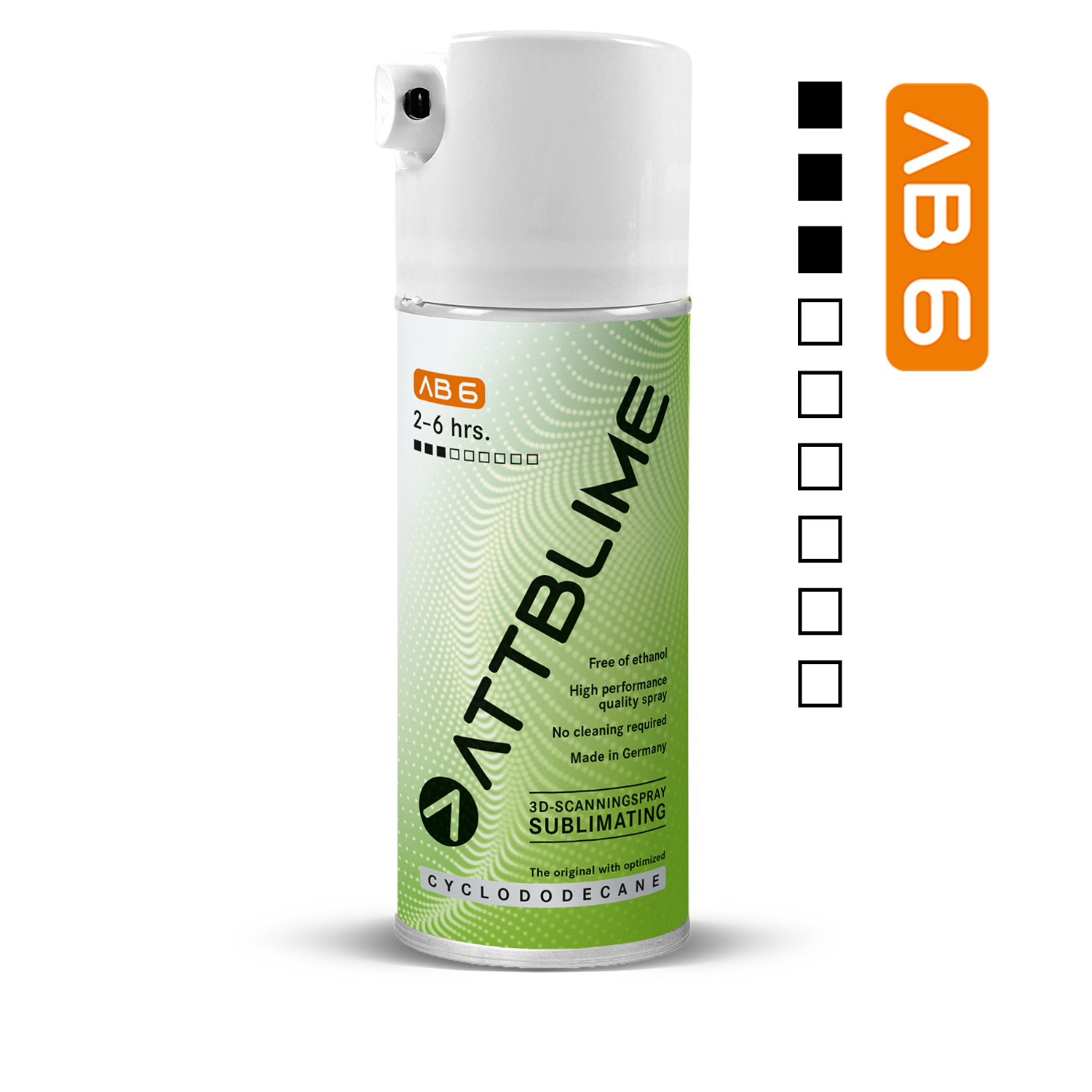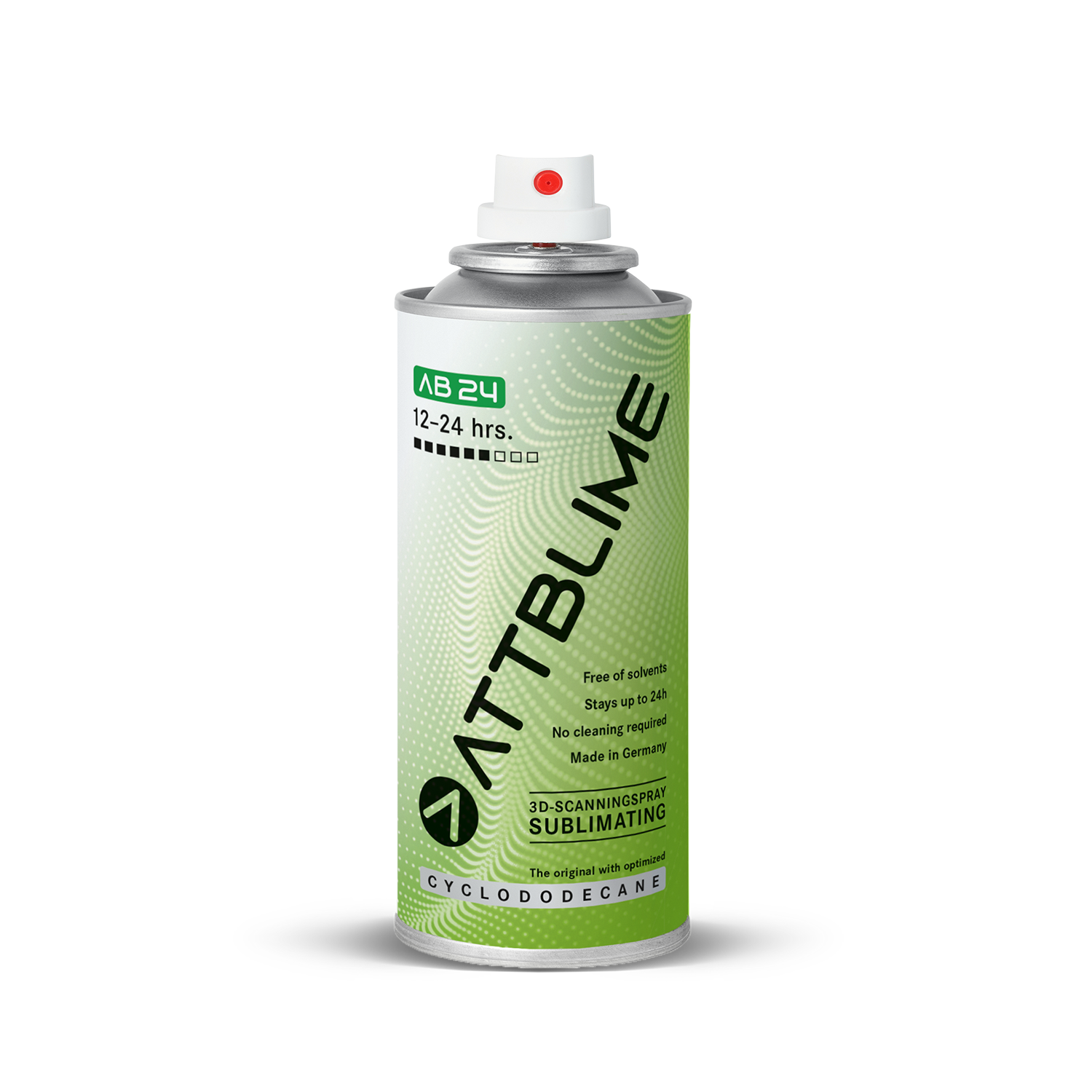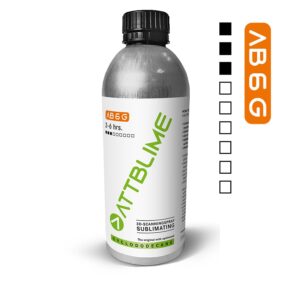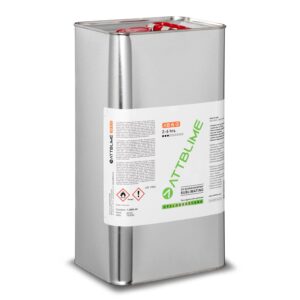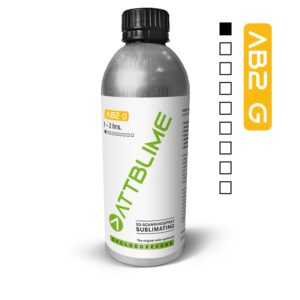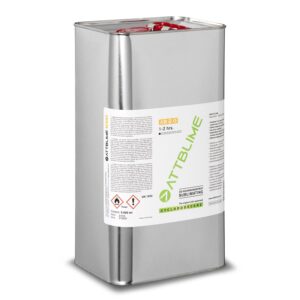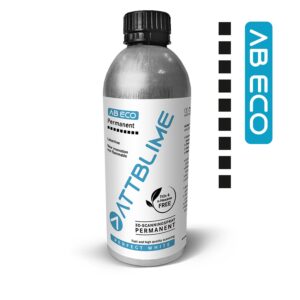ATTBLIME AB24 3D Sublimating Scanning Spray (Upto 24hrs)
ATTBLIME® AB24 offers temporary protection for sensitive surfaces when working with water and aqueous solutions, aqueous adhesives or mortars of any kind. This version with a particularly high percentage of cyclododecane allows users in the field of archeology and restoration to preserve objects and paintings as a high-performance sublimating spray.
In art, cyclododecane is used as a temporary fixative for delicate materials such as pastels, charcoal, and graphite. It can be sprayed (ATTBLIME AB24) onto the artwork to hold the materials in place while the artist works on other parts of the piece. Once the artwork is complete, the cyclododecane can be easily removed with a soft brush or cloth without damaging the surface of the artwork.
The cyclododecane spray is free from all solvents, titanium dioxide (TiO2) and adamantane. It adheres to all porous and non-porous surfaces such as textiles, wood, glass, painted surfaces, metal, plastic, stone, mortar and paper.
Cyclododecane is a waxy, water-repellent and non-toxic substance. It will disappear of its own accord after a few days through evaporation.
In particularly demanding areas of application of industrial 3D measurement technology, for example at high outside temperatures > 30°C, such as the Asian market, ATTBLIME AB24 with its even and homogeneous spray pattern with a layer thickness of 32.36 µm can also be used for the temporary matting of surfaces. Here, the classic 3D scanning sprays sometimes simply do not achieve the required performance. Reference point marks can simply be stuck onto the treated area.
In this case, the effective scan time (scan time) is 12 to 24 hours. The sublimation time (sublimation time), i.e. the time in which the spray dissolves, is around 24 to 48 hours. These times vary depending on the environmental conditions such as the component surface, room temperature, air circulation or humidity.
The spray cans are equipped with the unique SHC system (spray-head-change-system), which enables the user to control the layer thickness and thus the sublimation times between vertical and horizontal, as well as wide and narrow exit angles.
How it Works
A 3D scanning spray, also known as a scanning agent or matting agent, is used to improve the accuracy of 3D scanning systems by creating contrast and highlighting features on the surface of an object.
The ATTBLIME® scanning spray contains either a sublimating agent or a non-sublimating agent (free of harmful pigments), which is applied to the surface of the object being scanned. It adheres to the surface and helps to absorb or reflect light in a way that makes it easier for the 3D scanner to detect the shape and contours of the object.
When the 3D scanner emits light onto the object, the layer creates a contrasting background that makes it easier for the scanner to identify the edges and details of the object. The scanner then captures multiple images of the object from different angles, which are combined to create a 3D model.
The layer also helps to reduce the effect of specular reflection, which occurs when the surface of the object reflects light directly back to the scanner, creating glare and reducing the quality of the scan. The layer diffuses the reflection, making it less intense and improving the accuracy of the scan.
Overall, the ATTBLIME® Scanning spray improves the quality and accuracy of 3D scans by creating contrast and reducing glare, making it an important tool for many applications, including industrial inspection, quality control, and reverse engineering.
GHS
Bulk
Non Hazardous
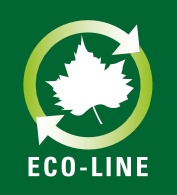
FAQ
Q: What is 3D scanning spray?
A: 3D scanning spray is a powder-based solution that is used to improve the accuracy and quality of 3D scanning systems. It helps create contrast and highlights features on the surface of an object being scanned, making it easier for the scanner to detect and capture the object's shape and details.
Q: What types of surfaces can I use scanning spray on?
A: Scanning spray can be used on a variety of surfaces, including smooth or rough, shiny or dark and transparent surfaces. It can be used on all types of substrates such as textiles, wood, glass, painted surfaces, metal, plastic, stone, mortar and paper. However, it is recommended to test a patch for sensitive applications before use. ATTBLIME® offers a variety of products to suit specific application needs.
Q: How do I apply scanning spray to an object?
A: ATTBLIME® Scanning products can be applied using air-brush, spray gun, aerosols and can be used for both in-line and off-line applications. The product is applied evenly over the surface of the object being scanned, ensuring that it covers all areas of interest.
Q: Do I need to clean the object after applying scanning spray?
A: It depends on the choice of the Scanning product being used. ATTBLIME® Sublimating product range do not require any post-cleaning. It leaves the surface residue-free post sublimation.
However, while using ATTBLIME® Non-Sublimating products, it is recommended to clean the object after scanning to remove any remaining powder. This can be done easily by using a soft cloth or brush and/or a gentle cleaning solution.
Q: Can scanning spray damage the object being scanned?
A: ATTBLIME® Scanning spray is generally safe to use on most surfaces and does not cause damage. However, it is important to test the spray on a small area first to ensure that it does not react negatively with the material or finish of the object being scanned.
Q: How much scanning spray should I use?
A: The amount of scanning spray needed will depend on the size and shape of the object being scanned. It is recommended to apply a thin, even layer of powder to the surface of the object, ensuring that all areas of interest are covered.
Q: Can I reuse the scanning spray?
A: Scanning spray can not be reused.
Q: How do I store the scanning Spray?
It is recommended to store the products in a cool, dry place and avoid exposure to moisture or humidity.
Q: Can I scan an object without using scanning spray?
A: It is possible to scan some objects without using scanning spray, especially if they have a matte surface or are well-lit. However, scanning spray can significantly improve the quality and accuracy of the scan, especially for complex or reflective surfaces.
Q: Why does my spray evaporate quicker than that mentioned on the product?
A: ATTBLIME® Scanning sprays are tested for its sublimating time under ideal conditions and may vary depending on the room temperature, component surface, air circulation & humidity.
Q: Why does my spray take longer to evaporate than that mentioned on the product?
A: ATTBLIME® Scanning sprays are tested for its sublimating time under ideal conditions and may vary depending on the room temperature, component surface, air circulation & humidity
Q: How do I choose an appropriate Scanning Spray?
A: ATTBLIME® offers a wide range of scanning spray and systems. You can write to us with your application and basic required and our team of experts can get back to you with a suitable product.
Q: Can I order samples of Attblime products?
A: Yes, ATTBLIME offers promo boxes for customers to try our products. The promo boxes are available in select countries. Please write to us at sales@3akchemie.com for the same.
Q: What is the difference between Effective Scan Time and Sublimation time?
A: Effective Scan Time is the actual intact duration that the coated layer stays before sublimating. Sublimation Time is the time required for the coated layer to fully sublime. However, it may vary depending on the room temperature, component surface, air circulation & humidity.
Q: What is special about the ATTBLIME® Cyclododecane?
A: ATTBLIME® Cyclododecane has a minimum purity of 99.9% and is specially modified to suit the 3D scanning industry.
Q: What is ATTBLIME® SHC?
A: ATTBLIME® SHC stands for Spray Head Change system is a unique spray mechanism which enables users to choose between vertical ad horizontal, as well as broad and narrow exit angles, to control the film thickness and thus sublimation time.
Q: What is cyclododecane?
A: Cyclododecane is a cyclic hydrocarbon with the chemical formula C12H24. It is a white, waxy solid with a mild, pleasant odour.
Q: What are the properties of cyclododecane?
A: Cyclododecane has a low vapour pressure and melting point, which allows it to solidify and maintain its shape. It is also non-toxic, non-flammable, and biodegradable.
Q: What is cyclododecane used for?
A: Cyclododecane is commonly used as a temporary fixative in art, a protective coating in conservation and restoration, and a mould-making material in sculpture and other forms of artwork. It is also used in the preservation of fossils.
Q: Is cyclododecane safe?
A: Cyclododecane is considered to be a relatively safe substance. It is non-toxic, non-flammable, and biodegradable. However, it is still important to follow proper safety procedures when handling any chemical substance.
Q: How do you remove cyclododecane?
A: Cyclododecane can be easily removed by gently brushing or wiping the surface with a soft cloth or brush. It can also be removed with solvents such as alcohol or acetone.
Q: Can cyclododecane be reused?
A: Cyclododecane can be reused if it is collected and melted down to form a new layer. However, it may become contaminated with dust or debris over time, which could affect its effectiveness as a fixative or protective coating.
Q: Is cyclododecane environmentally friendly?
A: Cyclododecane is biodegradable and does not have a negative impact on the environment. However, it is still important to dispose of it properly and follow proper safety procedures when handling any chemical substance.


